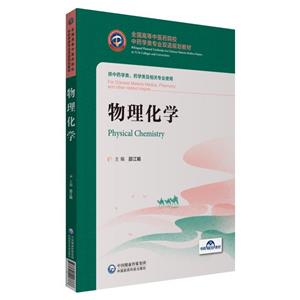Introduction
Section 1 Research Objects, Methods and Contents of Physical Chermistry
Section 2 Learning Methods of Physical Chemistry
Section 3 Applications of Physical Chemistry to Medicine
Chapter 1 The First Law of Thermodynamics and Thermochemistry
Section 1 The Basic Concepts
1.1 System and surroundings
1.2 Extensive and intensive properties
1.3 Equilibrium
1.4 State and state function
1.5 Process and path
1.6 Heat and work
Section 2 Work and Process
2.1 The general expression for work
2.2 Free expansion
2.3 Expansion against constant pressure
Section 3 Reversible Process
3.1 Reversible expansion
3.2 Isothermal reversible expansion
3.3 Features of reversible processes
Section 4 The First Law of Thermodynamics and Thermodynamic Energy
4.1 Empirical expression of the first law of thermodynamics
4.2 Thermodynamic energy
4.3 Mathematical equation of the first law of thermodynamics
Section 5 Enthalpy
5.1 Special significance of heat in constant volume and constant pressure process
5.2 Definition and properties of enthalpy
Section 6 Heat Capacity
6.1 Definition of heat capacity
6.2 Constant volume heat capacity and constant pressure heat capacity
6.3 Empirical equation of heat capacity
Section 7 Application of the First law of Thermodyna mics to Ideal Gas
7.1 Ideal gas
7.2 The relationship between C,and C, of ideal gas
7.3 Joule experiment
7.4 Isothermal Process of ideal gas
7.5 Adiabatic process of ideal gas
Section 8 Thermal Effects of Chemical Reaction
8.1 Relationship between reaction heat at constant volume and reaction heat at constant pressure
8.2 Thermochemical equation
8.3 Hess's Law
Section 9 Several Thermal Effects
9.1 Standard Heat of Formation
9.2 Standard Heat of Combustion
Section 10 The Relationship between Heat of Reaction and Temperature - Kirchhoff s Law
Chapter 2 The Second Law of Thermodynamics and Chemical Equilibrium
Section 1 The Second Law of Thermodynamics
1.1 Common characteristics of the spontaneous process——irreversibility
1.2 Empirical description of the second law of thermodynamics
Section 2 Carnot Cycle and Carnot Theorem
2.1 Carnot Engine
2.2 Carnot's theorem
Section 3 Concept of Entropy —Entropy and Entropy Increase Principle
3.1 Heat-temperature quotient of reversible cyclic processes and reversible processes——entropy function
3.2 Heat-te mperature quotient of irreversible cyclic processes and irreversible processes
3.3 The principle of entropy increase
3.4 Entropy criterion
Section 4 Essence of the Second Law: Statistical Significance of Entropy
4.1 Entropy and thermodynamic probability —Boltzmann formula
4.2 Essence of the second law of thermodynamics
Section 5 Calculation of Entropy Change
5.1 Entropy change in the process of simple state change
5.2 Entropy change of phase change
5.3 Calculation of molar entropy
5.4 The third law of thermodynamics
Section 6 Helmholtz Function and Gibbs Function
6.1 Helmholtz function (work function)
6.2 Gibbs function (free energy)
6.3 Calculation of Gibbs function
Section 7 the Relationship between Thermodynamic State Functions
7.1 Fundamental relations of thermodynamics
7.2 Maxwell relations
Section 8 Partial Molar Quantity and Chemical Potential
8.1 Partial molar quantity
……
Chapter 3 Phase Equilibrium
Chapter 4 Electrochemistry
Chapter 5 Chemical Kinetics
Chapter 6 Surface Phenomena
Chapter 7 Sol
Chapter 8 Macromolecular Solution
Appendix(附錄)
參考文獻















